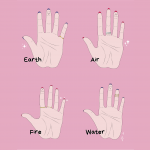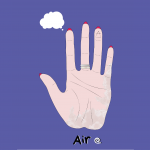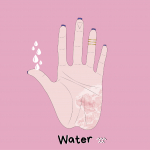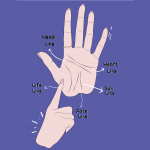
Beginners guide to palm reading
To find out what our hands tell us according to this ancient practice
May 22nd, 2020
Among the topics that fascinate and intrigue nss G-Club, in addition to the world of Astrology and the zodiac signs, there is the one of reading palms, in "official" terms palmistry. Palmistry is a controversial practice today, often considered unreliable, but actually derives from a very ancient form of divination, born more than 2500 years ago probably in India and then spread throughout the world. Aristotle deepened the reading of the palms in the work De Historia Animalium (History of Animals). It is often confused with tarot reading or with the birth chart interpretation, but it is actually a more "personal" and variable practice.
Like all esoteric practices, palmistry is very complex and elaborate so we limit ourselves here to illustrating the basics, in an introductory guide to reading hands signed by nss G-Club. To deepen the reading of the hands you need a lot of information such as the length and proportion of the fingers, it is an in-depth study of the topic.
Through the analysis of some elements like the main lines of the hands, it is, however, possible to know the basics of palmistry.
What is palmistry
It is, in short, the art of analyzing the physical characteristics of the hands to interpret personality features and predict future events. It is based, like other esoteric traditions, on the axiom "As above, so below" where the palm of the hand is in this case seen as the microcosm of the universe (macrocosm). To start approaching the analysis of the palms it is good to know that it is not only the dominant hand that needs to be analyzed, although this provides the main information on the personality, both to get a more complete picture.
The four elements and the types of hand
You can start by familiarizing yourself with the shapes of the hands that correspond to the four elements: fire, earth, air and water. The next step is to learn to recognize the mounts of the hand, the regions that correspond to the main areas of life. Returning to the elements, they are the same that we find in astrology, but be careful: your astrological element may not correspond to your type of hand.
The hand-tied to the element of the Earth has a square palm and rather short fingers, giving the hand a solid, robust, fleshy shape. These characteristics usually belong to practical, logical and grounded individuals. Although safe and reliable, they can be instinctive at times, which can hinder long-term planning and results. The type of hand-linked to Fire is characterized by long palm and short fingers, and they belong to people who are usually strong, confident, and ambitious, guided by their desires. The hands of the Air type have square palms and long and thin fingers; this type of hand indicates intellectually curious individuals with innate analytical and communication skills, who are easily distracted and, if not stimulated, can become anxious or irritable. Finally, the last element is Water, which characterizes the hands with long palms and long fingers, soft to the touch; water is the element of emotional people, with great intuition, fueled by compassion and imagination, often very creative. They are also extremely sensitive people and their feelings are easily hurt, sometimes causing interpersonal stress.
The lines
The first thing that comes to mind thinking about reading the hand is probably the image of an old suspicious-looking fortune teller drawing lines on the hand in a dark and mysterious room with red velvet curtains. While this stereotype can be considered somewhat dated, it is not entirely meaningless, being a recurring stereotype in popular culture such as fairy tales, films, books. The folds of the palms referred to as lines, are used to predict future events.
The reading of the headline plays on the fact that our mind, our curiosity and intellectual activity have a key role in shaping our "destiny"; the complexity of an individual's mental activities corresponds to the depth of the line, while the length of the line reveals the number of topics explored; breaks in the line can mean internal conflicts or, more optimistically, sensational breakthroughs.
The heart line, on the other hand, also known as the "love line", is linked to all sentimental and emotional issues, such as romance, friendship, sexuality and relationships; if the heart line begins below the index finger, it reveals certain stability and contentment in relationships, if it starts under the middle finger, it reveals potential restlessness; breaks in the line may suggest the presence of multiple lovers, and even infidelity.
We continue with the line of life which is the most controversial: we are led to think in fact, erroneously, that indicates the duration of life, and this can create anxiety and concern; it is not so, the line of life is in fact used to evaluate one's own journey, lived experiences, vitality; the depth of the line suggests the richness of your experience, while the length reveals the influence of others on your individual path. In short, a short lifeline is not synonymous with a bad omen, indeed, it indicates an individual with strong independence and autonomy.
The fate line is the vertical crease in the centre of the palm which reveals the degree to which an individual's life will be influenced by external circumstances beyond his or her control. It is the line of the hand that transforms most frequently: every time you are experiencing a great change, personal or professional, take a quick look at the fate line and check if it has changed.
Finally, the line of the sun (or Apollo's line), is the vertical fold most moved towards the little finger of the hand and reveals its public image, fame and popularity. The line of the sun varies greatly in length, depth and position and demonstrates how and when an individual will achieve success. If the line of the sun and the line of destiny intersect or run parallel, they indicate that the success of an individual will be the result of external events, beyond his control. If the line of the sun and the line of destiny are not close together, they suggest that an individual's success will be built more independently of external influences.
The mounts of the hands
Let's look at the natural topography of the palm. The "fleshy" areas called mountains and plains are linked to different themes of life. The classic mountains correspond to the seven main planets: Apollo (the Sun), the Moon, Mercury, Venus, Mars, Jupiter and Saturn. The slightly raised mounts concern the well-balanced and well-proportioned personal characteristics, while the more sunken areas indicate an individual's "blind spots" or poorly developed qualities. Finally, the extremely high areas reveal dominant features that can be emphasized.
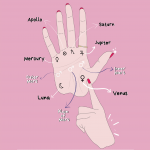
The mount of Jupiter indicates security, ambition and leadership. The mount of Saturn corresponds to wisdom, responsibility and strength of mind, revealing the integrity of an individual. Mount of Apollo derives its name from the "God of the Sun" of classical antiquity: this region of the hand corresponds to the optimism, vitality and ultimate essence of an individual, showing artistic inclinations, happiness and success. Mount of Mercury is connected to communication and intelligence, wit, social and adaptive skills, revealing an individual's strategic mind and resourcefulness. Then there is the mount of the Moon which stands for the imagination, intuition, reveals the empathy and imagination of an individual. Finally, the mount of Venus, linked to love, sensuality and attraction, shows the emotional connection of an individual with romance, sexuality, passion and indulgence.
Illustrations by @canihavemyspace exclusive for nss G-Club.

























































.jpg)







